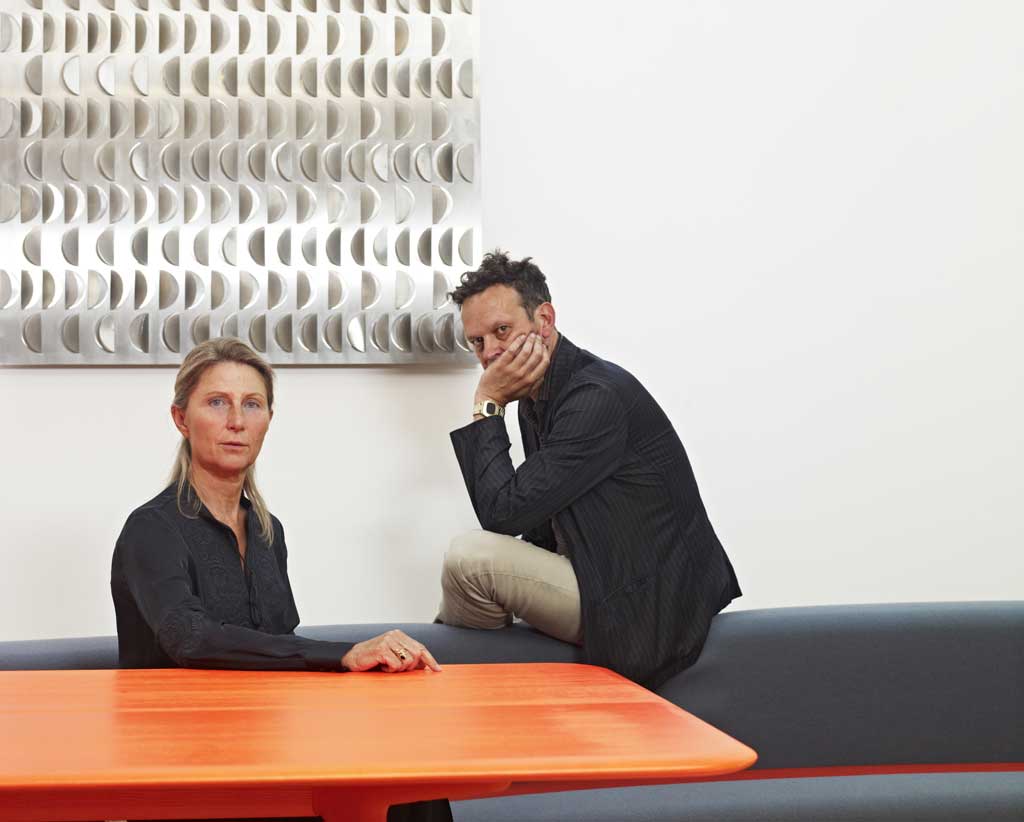How We Met: Liliane Fawcett & Tom Dixon
'I'd make something, drop it off and she'd give me £50 cash for it. It was a lifeline'

Tom Dixon, 53
Best known as the creator of the Pylon chair and the S-chair, the industrial-style designer has created objects and interiors for the likes of Terence Conran, Vivienne Westwood and Habitat – for which he also acted as creative director for 10 years. He runs his own, eponymous, design firm, and lives in London.
I knew Liliane initially as this interesting local French antiques dealer whose shop [Themes & Variations] was the only one in the area selling interesting design objects, mainly from the 1950s, 1960s and 1970s. Her shop was on Westbourne Grove [in west London] and my studio was just two blocks away.
For a long while, though, she wasn't very interested in what I was doing. She was far more interested in an artist I was sharing a studio with, André Dubreuil, who was more classic than me, and she started to buy his work for her shop. During that period, around 1985, UK galleries weren't really interested in the kind of rusty industrial chic I was doing.
Back then there was little interest in design in the Sunday supplements and no design museums, so her shop was a splash of colour and culture that didn't exist elsewhere.
On a Saturday I'd walk down Portobello Road, pass the vegetables, do the shopping, pass the knick-knack and vintage shops and end up at Liliane's, where we'd have conversations about the pieces in her shop. Then I'd look at some of the books and go home; I treated it more as a coffee shop than anything else.
Once she started to appreciate what I was doing, she was very generous. If I ever needed money I'd make something, drop it off and she'd give me £50 cash for it. It's a lifeline when you're starting out, having people to support you. And she became a great person to do the dirty work of selling; unlike most people in sales she was very honest. Now I don't consider her a collector, but a friend; I don't push her to buy anything any more.
It was many years later I discovered that she was a countess with a fabulous château in the South of France – she even has a museum there dedicated to the Knights Templar. She hosted her 40th birthday there and had a fairy-tale party. She comes from a very old family, but whereas most families in the French aristocracy are distant, she is so warm.
Liliane Fawcett, 55
A French countess, Fawcett first set up her London-based shop/gallery Themes & Variations in 1984, at the time promoting work from up-and-coming designers such as Tom Dixon and Israeli artist Ron Arad, as well as selling decorative arts and furniture from the 1960s and 1970s. She lives in the South of France.
I opened my gallery as I was interested in 1950s as well as contemporary design. It was a creative time in London and [new design was] an extension of the punk movement. Tom was the coolest kid in town – he was working in nightclubs and music at the time – and early in 1988 we had an exhibition of his work. It was so packed in there that it felt like a riot.
Tom was scavenging pieces of metal from pavements, from railings and turning it into furniture, which for me was completely new; rough but sophisticated, such as his frying-pan chair, which in some sense looked rough but the welding was made in brass, which turned it into something sophisticated.
After that first exhibition, he'd often come to the gallery on a Saturday and we'd just chat about life and design. He liked our vintage pieces from the 1950s and appreciated what other designers had done before him. I think the friendship started because he speaks fluent French, as he's partly Tunisian.
I love his pieces now – I collect all I can find, particularly his early chairs made from Victorian railings and manholes.
Some people find him terrifying, as if he is not in the mood, he's not going to speak; he does a lot of grunting. But my father didn't speak that much either, so I don't find that threatening and [for me] he's easy-going, it's just that the English [side to him] is quite reserved, he'd never pour his heart out. From time to time, though, he does put me in my place. I faff around with so many ideas about things we could do, and he just says "Yes, but..."
We hang out socially in a very ad hoc way and he's been to my place in France several times. Once he came over and started welding [metal] animals over there – we this have rural environment – and when he left, they stayed here for ages. And of course he came to the party I held for my 40th birthday, bringing his young children along, too.
What do I like most about him? I think it's that a man with his genius could afford to be more arrogant. But he is a lesson in modesty, and that's worth cherishing in an art world where so many people are so full of themselves, yet with far less creativity than he has.
Themes & Variations, London W11 (themesandvariations.com) is hosting an exhibition entitled Chinese Design Today from Thursday to 8 December
Join our commenting forum
Join thought-provoking conversations, follow other Independent readers and see their replies
Comments